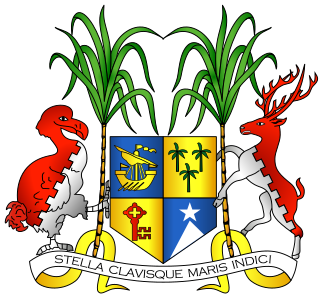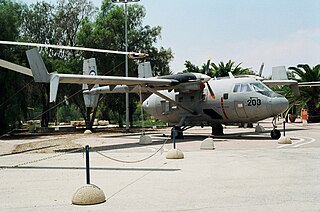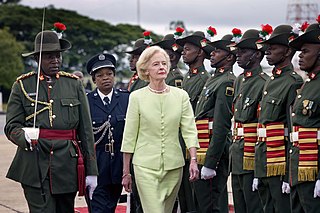
The Armed Forces of Gabon is the national professional military of the Republic of Gabon, divided into the Army, Air Force, Navy, and a National Gendarmerie, consisting of about 5,000 personnel. Gabonese forces are oriented to the defense of the country and have not been trained for an offensive role. The armed forces includes a well-trained, well-equipped 1,800-member guard that provides security for the President of Gabon.

The Armed Forces of the Republic of Kazakhstan is the unified armed forces of Kazakhstan. It consists of the Ground Forces, Air and Air Defence Forces, Naval Forces, and Republican Guard. The national defence policy aims are based on the Constitution of Kazakhstan. They guarantee the preservation of the independence and sovereignty of the state and the integrity of its land area, territorial waters and airspace and its constitutional order. The armed forces of Kazakhstan act under the authority of the Kazakhstan Ministry of Defence.

Mauritius does not have a standing army. All military, police, and security functions are carried out by 10,000 active-duty personnel under the command of the Commissioner of Police. The 8,000-member National Police Force is responsible for domestic law enforcement. The 1,500-member Special Mobile Force (SMF) and the 500-member National Coast Guard are the only two paramilitary units in Mauritius. Both units are composed of police officers on lengthy rotations to those services.

The Papua New Guinea Defence Force (PNGDF) is the military organisation responsible for the defence of Papua New Guinea. It originated from the Australian Army land forces of the territory of Papua New Guinea before independence, coming into being in January 1973 and having its antecedents in the Pacific Islands Regiment. The PNGDF is a small force numbering around 2,500 personnel and consists of a Land Element, an Air Element and a Maritime Element. It is a joint force tasked with defending Papua New Guinea and its territories against external attack, as well as having secondary functions including national-building and internal security tasks.

The Armed Forces of the Republic of the Congo, also less formally denoted as the Forces armées congolaises or its acronym FAC, are the military forces of the Republic of the Congo. They consist of the Congolese Army, the Congolese Air Force, the Congolese Marine (Navy), and the Congolese National Gendarmerie. The dissolution of French Equatorial Africa in 1958, and France's impending military withdrawal from the Congo in August 1960, provided the impetuous for the formation of the FAC. The FAC and state paramilitary agencies are headed by an Armed Forces Chief of General Staff, usually appointed by the President of the Republic of the Congo. Major General Guy Blanchard Okoï has served as chief of staff since 2012.

The Republic of Sierra Leone Armed Forces (RSLAF) is the armed forces of Sierra Leone, responsible for the territorial security of Sierra Leone's border and defending the national interests of Sierra Leone, within the framework of its international obligations. The armed forces were formed after independence in 1961, on the basis of elements of the former British Royal West African Frontier Force, then present in the country. The Sierra Leone Armed Forces currently consist of around 13,000 personnel.

Eswatini, officially the Kingdom of Eswatini and also known as Swaziland, is a landlocked country in Southern Africa. It is bordered by Mozambique to its northeast and South Africa to its north, west and south. At no more than 200 kilometres (120 mi) north to south and 130 kilometres (81 mi) east to west, Eswatini is one of the smallest countries in Africa; despite this, its climate and topography are diverse, ranging from a cool and mountainous highveld to a hot and dry lowveld.

Mswati III is the King of Eswatini and head of the Swazi Royal Family. He was born in Manzini, Eswatini, to King Sobhuza II and one of his younger wives, Ntfombi Tfwala. He was Tfwala’s only child. He attended primary school at Masundvwini Primary School and secondary school at Lozitha Palace School. From 1983 to 1986, he attended Sherborne School in north-west Dorset, England. He was crowned as Mswati III, Ingwenyama and King of Swaziland, on 25 April 1986 at the age of 18, thus becoming the youngest ruling monarch in the world at that time. Together with his mother, Ntfombi Tfwala, now Queen Mother (Ndlovukati), he rules the country as an absolute monarch. Mswati III is known for his practice of polygamy and currently has 15 wives. His policies and lavish lifestyle have led to local protests and international criticism.

The Pilatus PC-7 Turbo Trainer is a low-wing tandem-seat training aircraft, manufactured by Pilatus Aircraft of Switzerland. The aircraft is capable of all basic training functions including aerobatics, instrument, tactical and night flying. It has been selected by more than 20 air forces as their ab initio trainer. Since the aircraft's introduction in 1978, close to 500 have been sold, with the majority still in service. Over one million hours have been flown by PC-7s worldwide.

The Israeli Aircraft Industries Arava is a light STOL utility transport aircraft built in Israel by IAI in the late 1960s.
As part of the military of the United Arab Emirates, the United Arab Emirates Army is responsible for land operations.

Princess Sikhanyiso Dlamini is the current Minister of ICT of Eswatini and eldest daughter of King Mswati III of Eswatini.

Equipment of the Bangladesh Army is a list of the equipment currently in use in the Bangladesh Army. It includes small arms, vehicles, artillery, and aircraft.

The Malawian Defence Force is the state military organisation responsible for defending Malawi. It originated from British colonial units formed before independence in 1964.

The Djiboutian Army is the largest branch of the Djibouti Armed Forces and is based in the Djiboutian capital of Djibouti City. Djibouti has upgraded its Ground Forces with advanced additions from domestic engineering and modifications. It must operate in mountainous and other rugged terrain, but it must do this without affecting the mechanized capability that is needed to confront regional forces. The official tasks of the armed forces include strengthening the country against external attack, maintaining border security. It is responsible for the defence of mainland Djibouti. During peacetime the military of Djibouti numbers approximately 9,000 with a reserve force of approximately 7,000

The Zambian Army is part of the Zambian Defence Force, with Lieutenant General Paul Mihova as commander. Like all branches of the Zambian military, citizens of the nation are required to register at 16, and citizens can join at 16 with parental consent or at 18 when they are classified as adults by Zambia. There is no conscription. Applicants must be Zambian citizens and must have a Grade 12 certification. Applicants must also undergo a test for HIV on enlistment. Personnel can serve until age 65, when there is a mandatory retirement. Its first Major General was Michael Grigg, appointed by Kenneth Kaunda. According to the 2014 CIA World Factbook:
As a result of the effects of excess mortality due to AIDS, residents of Eswatini have nearly the lowest documented life expectancy in the world at 58.9 years; only four other countries have lower life expectancies.



















